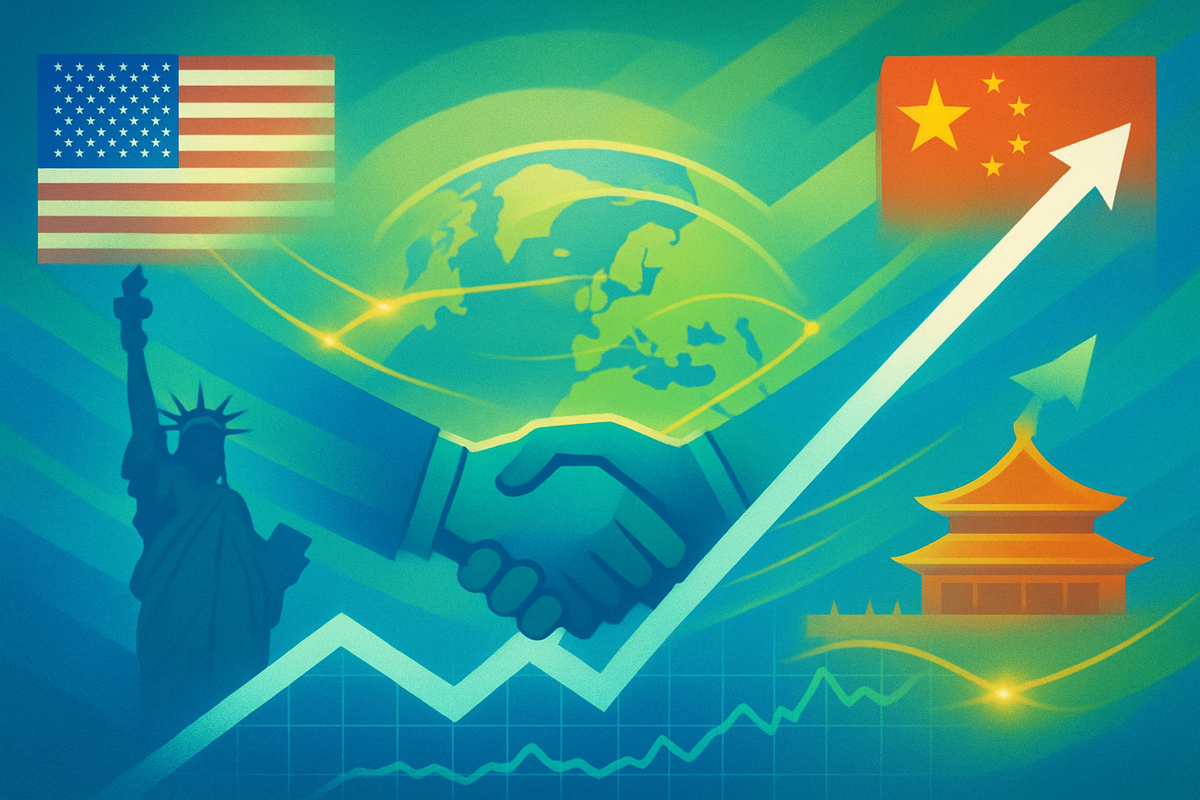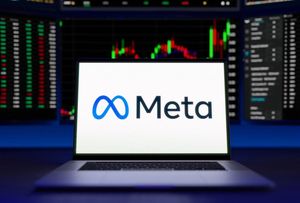
Global stock markets are experiencing a significant rally in October 2025, buoyed by a discernible easing of trade fears between the United States and China. A series of diplomatic overtures and a temporary tariff truce have injected a much-needed dose of optimism into a market long plagued by the specter of escalating protectionism. This shift marks a crucial pivot, offering a fragile reprieve and setting the stage for renewed confidence in international trade and investment.
The immediate implications are clear: a "risk-on" environment has taken hold, with major indices worldwide registering substantial gains. Investors are reacting positively to the prospect of stabilized supply chains, reduced operational costs, and enhanced market access, signaling a collective sigh of relief as the world's two largest economies appear to step back from the brink of a full-blown trade war.
A Timeline of Détente: From Escalation to Easing
The current de-escalation in China-US trade relations comes after a turbulent period marked by aggressive tariff impositions and retaliatory measures. The year 2025 saw a rapid escalation, with US tariffs on Chinese goods reaching a cumulative 145% by April 2, and China responding with similar increases, pushing two-way trade into severe decline. However, a series of strategic moves and diplomatic engagements began to reverse this trend.
A pivotal moment occurred on May 12, 2025, when both nations announced a 90-day pause and a dramatic reduction in bilateral tariffs. The US significantly lowered its tariffs on most Chinese imports from 145% to 30%, while China reciprocated, reducing its levies on US goods from 125% to 10%. This agreement, which also included commitments on fentanyl and established a mechanism for ongoing discussions, provided the first major sign of a thaw. News of upcoming high-level trade talks on May 8, 2025, and President Donald Trump's softened rhetoric on April 23, 2025, further fueled market optimism.
Leading up to October 20, 2025, President Trump continued to signal a more conciliatory approach. Following an earlier threat of a 100% tariff on Chinese imports around October 10, Trump stated on October 12 that higher tariffs were "not sustainable" and that "it will all be fine!" These remarks, coupled with confirmed high-level discussions between US Treasury Secretary Scott Bessent and Chinese Vice Premier He Lifeng, culminated in an agreement on October 20 to hold a new round of trade negotiations in Malaysia "as soon as possible." Global markets responded immediately, with Tokyo surging over three percent, Hong Kong advancing more than two percent, and Wall Street's main indices opening higher, showcasing the market's sensitivity to the "apparent softening in rhetoric concerning the reigniting of the trade war." Key players in these developments include President Donald Trump, Chinese President Xi Jinping, US Treasury Secretary Scott Bessent, US Trade Representative Jamieson Greer, and Chinese Vice Premier He Lifeng.
Corporate Fortunes: Winners and Losers in a Rebalancing Act
The easing of China-US trade tensions is poised to significantly impact public companies across various sectors, creating both clear winners and some potential losers as global supply chains and market access stabilize.
Technology Sector: This sector is among the biggest beneficiaries. Semiconductor companies with substantial revenue exposure to China, such as Qualcomm (NASDAQ: QCOM), Intel (NASDAQ: INTC), Nvidia (NASDAQ: NVDA), Applied Materials (NASDAQ: AMAT), Lam Research (NASDAQ: LRCX), Micron (NASDAQ: MU), and Texas Instruments (NASDAQ: TXN), stand to gain from reduced tariffs and fewer export restrictions. Easing tensions could reverse revenue losses experienced by companies like Nvidia due to AI chip export bans. Consumer electronics giant Apple (NASDAQ: AAPL), heavily reliant on Chinese manufacturing and a key player in the Chinese consumer market, is also expected to benefit from more predictable production and sales environments. Other tech behemoths like Microsoft (NASDAQ: MSFT), Alphabet (NASDAQ: GOOGL), Amazon.com (NASDAQ: AMZN), and Meta Platforms (NASDAQ: META), with significant Chinese market exposure, could see improved market access.
Agriculture Sector: American farmers, particularly those producing soybeans, pork, and corn, are set for a major boost. China was historically the largest market for US agricultural exports, and a return to pre-trade war purchasing levels would significantly increase demand and stabilize commodity prices.
Manufacturing and Industrials: Companies with extensive global operations, such as Ford (NYSE: F), Tesla (NASDAQ: TSLA), BorgWarner Inc. (NYSE: BWA), 3M (NYSE: MMM), Caterpillar (NYSE: CAT), and General Electric (NYSE: GE), will benefit from lower input costs, smoother supply chains, and expanded market access in China. Reduced tariffs mean improved profit margins and export revenues.
Consumer Goods and Retail: Retailers and apparel companies like Walmart (NYSE: WMT), Costco (NASDAQ: COST), Target (NYSE: TGT), Nike (NYSE: NKE), and Lululemon Athletica (NASDAQ: LULU) will see lower import costs, enhancing gross margins. Luxury brands may regain price competitiveness. Hospitality and casino operators with significant presence in Macau, such as Wynn Resorts (NASDAQ: WYNN) and Las Vegas Sands (NYSE: LVS), could see a boost from improved relations and increased tourism.
Conversely, some entities might face challenges. Companies that heavily invested in reshoring or diversifying supply chains away from China during the trade war might find their costly adaptations less advantageous if China becomes a more viable production hub again. Chinese domestic brands that gained market share due to anti-US sentiment might face renewed competition from foreign brands. Furthermore, China's recent tightening of rare earth export controls, citing national security, indicates that strategic materials remains a point of leverage, potentially impacting companies reliant on non-Chinese sources or those developing alternative supply chains for critical components like those used in EVs and defense.
Broader Implications: Reshaping Global Commerce
The easing of China-US trade fears in October 2025 is more than just a temporary market uplift; it reflects deeper trends and has wider significance for the global economy, regulatory landscape, and international partnerships.
This de-escalation fits into broader industry trends of supply chain diversification and de-risking. While a truce offers immediate relief, the underlying impetus for companies to adopt a "China+1" strategy – maintaining Chinese operations while building parallel supply lines in countries like Vietnam, India, or Mexico – remains strong. This push for resilience, driven by past disruptions and geopolitical rivalry, aims to mitigate future tariff risks and enhance supply chain robustness, even if it entails higher short-term costs. The European Union's response to China's rare earth export restrictions also highlights a global push for self-sufficiency in critical materials.
The ripple effects are global. Southeast Asian nations and other "bystander" economies could continue to see increased foreign direct investment as companies diversify. European manufacturers, often suppliers to Chinese factories or reliant on US markets, benefit from reduced uncertainty. However, China's export-driven economy has already faced significant disruption, impacting its GDP growth, and the long-term shift towards a more multipolar trade environment, with China expanding trade with emerging markets, will continue.
From a regulatory and policy perspective, the renewed dialogue could lead to a re-evaluation of US scrutiny on Chinese investment. However, certain escalatory measures persist. China's expanded export controls on rare earth materials and lithium-ion batteries, as well as new reciprocal port fees implemented by both nations in October 2025, underscore the continued use of non-tariff barriers as strategic policy instruments. Historically, this situation draws parallels to the 2020 Phase One Trade Deal, which offered a partial de-escalation but ultimately failed to resolve deep structural issues, partly due to the COVID-19 pandemic. The May 2025 Geneva Truce, which significantly rolled back tariffs, also demonstrated that economic pressures can compel temporary de-escalation, but fundamental competition often persists.
The Road Ahead: Navigating Persistent Uncertainty
While the current easing of tensions offers a welcome respite, the path forward for China-US trade relations is likely to remain complex and characterized by persistent, albeit managed, uncertainty. Both short-term opportunities and long-term strategic challenges will shape the global economic landscape.
In the short term, the market optimism is expected to continue, driven by the tariff reductions and renewed diplomatic engagement. Industries like agriculture, aerospace, medical devices, and clean energy are poised for increased trade flows as Chinese tariffs on US goods decrease. This period offers businesses a chance to stabilize operations and potentially re-engage in cross-border trade with greater predictability. However, the 90-day tariff truce, extended in August, is set to expire on November 10, 2025. The outcome of the anticipated meeting between President Trump and President Xi Jinping at the APEC summit on October 31, 2025, and subsequent high-level talks, will be critical in determining if this de-escalation translates into a more durable agreement or if tensions reignite.
For the long term, businesses must continue to prioritize strategic pivots. The "China+1" supply chain diversification strategy will remain crucial, as companies seek to reduce over-reliance on any single manufacturing hub. Regionalization and nearshoring efforts, especially in sectors like automotive and electronics, will also gain traction. Investment in technological innovation, both in China for indigenous development and in the US for alternative raw material sourcing (e.g., rare earths), will be vital. While temporary truces offer breathing room, the underlying structural issues – such as China's industrial policies and intellectual property concerns – are unlikely to be fully resolved quickly, ensuring continued volatility. Market opportunities will emerge from reduced costs for consumers and manufacturers, increased access to the Chinese market for specific US exports, and growth in industrial and AI sectors. However, challenges persist, including the risk of renewed tariffs, China's leverage over critical materials, and the need for US domestic industries to compete with potentially cheaper imports if tariffs are significantly reduced.
A Cautious Optimism: What Investors Should Watch For
The easing of China-US trade fears in October 2025 has undoubtedly brought a wave of positive sentiment to global markets, offering a valuable opportunity for economic stabilization. The key takeaway is a shift from aggressive escalation to a period of cautious engagement, driven by mutual economic pressures and a recognition of the need for dialogue.
Moving forward, the market is expected to remain sensitive to any news emanating from the ongoing negotiations. While the immediate outlook is one of renewed investor confidence and potential for growth in trade-sensitive sectors, the underlying strategic competition between the US and China remains a defining feature of the global economic landscape. The "China+1" strategy and efforts towards supply chain resilience are not temporary measures but rather long-term adaptations to a new geopolitical reality.
Investors should maintain an agile approach and closely monitor several critical factors in the coming months:
- Upcoming Negotiations: The outcome of the Trump-Xi meeting on October 31 and the November 10 tariff truce deadline will be paramount. Any failure to reach a more durable agreement could trigger renewed market volatility.
- Policy Shifts: Watch for any changes in US or Chinese policy regarding tariffs, export controls (especially on rare earths and critical minerals), and investment restrictions.
- Geopolitical Developments: Broader issues such as Taiwan, cybersecurity, and intellectual property will continue to influence the trade relationship.
- Economic Data: Global GDP forecasts, inflation figures, and corporate earnings reports will provide real-time indicators of the trade policies' impact.
- Supply Chain Resilience: Assess how companies are adapting their supply chains and diversifying their manufacturing bases to mitigate future risks.
In conclusion, while October 2025 has offered a welcome, albeit fragile, de-escalation of trade tensions, investors should exercise cautious optimism. The current détente is a moment to breathe, but the long-term trajectory points towards continued strategic competition, necessitating sustained vigilance and adaptive strategies from businesses and investors alike.
This content is intended for informational purposes only and is not financial advice







